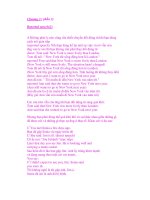Reported speech presentation
Bạn đang xem bản rút gọn của tài liệu. Xem và tải ngay bản đầy đủ của tài liệu tại đây (690.36 KB, 38 trang )
“ Add your company slogan ”
REPORTED SPEECH
CÂU TƯỜNG THUẬT
LOGO
A. Direct VS Reported speech
Similarity: Luôn có 2 phần: mệnh đề tường thuật và lời nói trực tiếp
hay lời nói gián tiếp
Tom says, “I like playing football”
MĐTT
Tom says (that) he likes playing Lời
football
nói trực tiếp
MĐTT
Lời nói gián tiếp
A. Direct VS Reported speech
Direct speech
Reported speech
- Thuật lại với ý và từ của người thuật,
- Nguyên văn của người nói.
- Đặt trong dấu
“” và ngăn cách với MDTT
nhưng vẫn giữ nguyên ý. Không có
“” và ,
bằng dấu ,
luôn tận cùng bằng dấu .
- John said, “I like reading science books”
- John said (that) he liked reading science
- The teacher said, “I’ll give you a test
books.
tomorrow”
- The teacher said (that) he would give us a
test the next day.
Difference:
B. Các thay đổi trong câu gián tiếp
1. Thay đổi động từ tường thuật:
Động từ tường thuật của lời nói gián tiếp phải được đổi phù hợp với nghĩa hoặc
cấu trúc câu của lời trực tiếp.
E.g.
- He said, “Do you like coffee?”
He asked me if I liked coffee
- “If I were you, I’d not buy that coat,” said Mary
Mary advised me not to buy the coat
B. Các thay đổi trong câu gián tiếp
2. Thay đổi các ngôi (đại từ, tính từ, đại từ sở hữu):
E.g. Mr Nam said to Hoa, “You take your book out and show it to me”
- Tình huống 1: Một người bạn của Hoa tường thuật với người bạn khác:
Mr Nam told Hoa that she took her book out and showed it to him.
B. Các thay đổi trong câu gián tiếp
- Tình huống 2: Hoa tường thuật với một người bạn khác:
Mr Nam told me that I took my book out and showed it to him.
- Tình huống 3: Thầy Nam tường thuật với người khác:
I told Hoa that she took her book out and showed it to me.
Verb change?
B. Các thay đổi trong câu gián tiếp
3. Thay đổi thời gian, địa điểm, các từ chỉ định.
a. Từ chỉ thời gian
Câu trực tiếp
Câu gián tiếp
- now then, at that time, at once, immediately
an hour before/an hour earlier
- an hour ago that day
- today that night
- tonight the day before/the previous day
- yesterday the next day/the following day
the previous morning/afternoon
- tomorrow
- yesterday morning/afternoon
B. Các thay đổi trong câu gián tiếp
Câu trực tiếp
Câu gián tiếp
- Tomorrow morning the next/following morning
- the day before yesterday two days before
- the day after tomorrow
-
last year (in) two days’ time
- next month the year before/the previous year
the month after/the following month
B. Các thay đổi trong câu gián tiếp
b. Từ chỉ nơi chốn, địa điểm:
* HERE THERE: Khi chỉ một địa điểm xác định
E.g.: “Do you put the pen here?” he said.
He asked me if I put the pen there.
* HERE cụm từ thích hợp tùy theo nghĩa:
E.g. - She said to me, “You sit here”
She told me to sit next to her.
- “Come here, John,” he said.
He told John to come over him.
B. Các thay đổi trong câu gián tiếp
c. Các đại từ chỉ định:
* THIS/THESE + từ chỉ thời gian
THAT/THOSE + từ chỉ thời gian.
E.g. - “They’re coming this evening,” he said.
He said (that) they were coming that evening
* THIS/THESE + danh từ THE + danh từ.
E.g.
- “Is this book yours?” said Mary
Mary asked me if the book was mine.
B. Các thay đổi trong câu gián tiếp
THIS/THESE: chỉ thị đại từ IT/THEM
E.g. - He said, “I like this”
He said (that) he liked it.
- Ann said to Tom, “Please take these into my room”
Ann asked Tom to take them into her room
B. Các thay đổi trong câu gián tiếp
4. Thay đổi thì của động từ
a. Các trường hợp thay đổi thì:
Khi các động từ tường thuật (say, tell, ask…) ở thì quá khứ, động từ trong câu
gián tiếp phải lùi về quá khứ một thì so với câu trực tiếp.
Câu trực tiếp
Câu gián tiếp
Simple Present: “I don’t know this
Simple Past: He said he didn’t know that
man”
man
Present Continuous: “I’m working
Past Continuous: He said he was
for a foreign company”
working for a foreign company
Present Perfect: “I’ve read a good
Past Perfect: He said he had read a good
book”
book
Present Perfect Continuous: “I have
Past Perfect Continuous: He said he
been writing my report”.
had been writing his report.
Câu trực tiếp
Câu gián tiếp
Simple Past: “I finished my
Past Perfect: He said he had finished his
assignment”
assignment.
Simple Future: “I will do it later”
Future in the past: He said he would do
Modal Verbs:
it later.
“I can work late today”
Past forms of modals:
“I may see her tonight”
He said he could work late that day.
“I must/have to go now”
He said he might see her that night.
He said he had to go then.
B. Các thay đổi trong câu gián tiếp
b. Các trường hợp không thay đổi thì:
Khi động từ tường thuật (say, tell, ask…) ở thì hiện tại đơn, tương lai đơn hay
hiện tại hoàn thành:
- E.g. - He says, “I don’t know the answer to your question”
He tell me that he doesn’t know the answer to my question
- They’ll say, “We’ll buy a new house”
They’ll say (that) they will buy a new house
B. Các thay đổi trong câu gián tiếp
Khi động từ tường thuật (say, tell, ask…) ở thì quá khứ, không đổi thì trong các trường hợp sau :
Tường thuật một sự thật hiển nhiên, một chân lý, định luật khoa học hay vật lý:
E.g. - My teacher said, “Russia is the biggest country in the world”
My teacher said that Russia is the biggest country in the world
- He said, “health is more precious than gold”
He said (that) health is more precious than gold
B. Các thay đổi trong câu gián tiếp
Được tường thuật ngay sau khi nói hay khi thuật lại sự kiện vẫn không đổi:
E.g. (In class): A: What did the teacher say?
B: He said (that) he wants us to do our homework
Khi động từ trong câu trực tiếp là các động từ như: used to, hay các động từ
khiếm khuyết: could, would, should, might, ought to, had to, had better
E.g. He said, “They might win the game”
He said to me that they might win the game.
B. Các thay đổi trong câu gián tiếp
Với MUST diễn tả lời khuyên:
E.g. “This book is very useful. You must read it”, Tom said to me.
Tom told me (that) the book was very useful and I must read it.
Khi động từ trong câu trực tiếp ở các thì: Past Continuous, Past perfect, Past
Perfect Continuous, (nếu thì Simple Past đi kèm một thời gian cụ thể có thể
không thay đổi thì).
E.g. He said, “I was eating when he called me”
He told me he was eating when he called him.
B. Các thay đổi trong câu gián tiếp
Khi tường thuật mệnh đề ước muốn (wish): theo sau động từ WISH, WOULD
RATHER, IF ONLY
E.g.
- He said, “I wish I were richer”
He told me he wished he were richer.
- She said, “I wish I had a good memory”
She said she wished she had a good memory.
B. Các thay đổi trong câu gián tiếp
Các câu điều kiện loại 2, 3 (câu điều kiện không thật)
E.g. - He said, “If I had time, I would help you”
He told me if he had time, he would help me.
Cấu trúc “It’s (high) time…”
E.g. - He said, “It’s time we went”
He said it was time they went.
- Hesaid,“It’stimewechangedourwayofworking”
He said (that) it was time they changed their
way of working.
C. Các loại câu gián tiếp
1. Tường thuật câu trần thuật (statements)
- Dùng say hoặc tell để tường thuật
- Thường bắt đầu bằng: He said that…./she said to me that…/they told me
that….,
E.g. She said, “I’m happy to see you again”
She said that she was happy to see me again
She told me that she was happy to see me
again
She said to me that she was happy to see
me again
C. Các loại câu gián tiếp
2. Tường thuật câu hỏi (questions)
a. Đối với câu hỏi trực tiếp (Wh-question)
- Thường bắt đầu bằng: He asked (me) …/He wanted to know…/She wondered….
E.g. She asked, “What is his job?”
She asked what his job was.
They asked me where I had lunch.
- Note 2 NOs: no auxiliary, no question mark.
Direct?
C. Các loại câu gián tiếp
b. Đối với câu hỏi “Yes – No” câu hỏi lựa chọn “Or”, câu hỏi láy đuôi “tag question”
- Phải thêm từ “if/whether” để mở đầu câu tường thuật
E.g.
- She asked, “Are you a teacher?”
She asked him if/whether he was a teacher
- They asked me, “Do you want to go or
stay at home?”
They asked me if/whether I wanted to go or stay at home.
C. Các loại câu gián tiếp
3. Câu tường thuật với “infinitive”:
a. Tường thuật câu mệnh lệnh, yêu cầu (Imperatives/Commands or Requests)
dùng cấu trúc: tell/ask/request/order somebody (not) to do something
E.g. “Read carefully before signing the contract” he said.
He told me to read carefully before signing the contract.
More e.g.
C. Các loại câu gián tiếp
- The commander said to his soldier, "Shoot!"
The commander ordered his soldier to shoot.
- “Don’t talk loudly” they said.
They requested us not to talk loudly.
- “Don’t listen to him!” he said.
He asked me not to listen to him.
- “Will you help me, please?”
He asked me to help him.
- “Will you lend me your dictionary?”
He asked me to lend him my dictionary.









